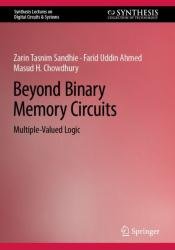Beyond Binary Memory Circuits: Multiple-Valued Logic
- Добавил: literator
- Дата: 14-11-2022, 14:34
- Комментариев: 0
 Название: Beyond Binary Memory Circuits: Multiple-Valued Logic
Название: Beyond Binary Memory Circuits: Multiple-Valued LogicАвтор: Zarin Tasnim Sandhie, Farid Uddin Ahmed, Masud H. Chowdhury
Издательство: Springer
Серия: Synthesis Lectures on Digital Circuits & Systems
Год: 2022
Страниц: 110
Язык: английский
Формат: pdf (true), epub
Размер: 10.2 MB
This book provides readers with an overview of the fundamental definitions and features of Multiple-Valued Logic (MVL). The authors include a brief discussion of the historical development of MVL technologies, while the main goal of the book is to present a comprehensive review of different technologies that are being explored to implement multiple-valued or beyond-binary memory circuits and systems. The discussion includes the basic features, prospects, and challenges of each technology, while highlighting the significant works done on different branches of MVL memory architecture, such as sequential circuits, random access memory, Flash memory, etc.
Computing technologies are currently based on the binary logic/number system, which is dependent on the simple on and off switching mechanism of the prevailing transistors. With the exponential increase in data processing and storage needs, there is a strong push to move to a higher radix logic/number system that can eradicate or lessen many limitations of the binary system. Anticipated saturation of Moore’s law and the necessity to increase information density and processing speed in the future micro and nanoelectronic circuits and systems provide a strong background and motivation for the beyond binary logic system.
There are lots of research proving that the ternary logic system is the most efficient and cost-effective than other logic system. In a ternary system (base 3 or more), each logic bit can have three possible values leading to significantly higher information density with smaller logic gates and reduced circuit complexity. As a result, the energy consumption, area, and circuit overheads, and other costs for each bit of information would decrease in the ternary system. The computational complexity decreases manyfold in a ternary system, which in turn enhances the power and area efficiency of the whole system. The existing technologies like MOSFET, FinFET, and FDSOI are not flexible enough to hold three distinguished voltage levels with proper noise margin. Hence, the concept of using different emerging technologies comes into view.
The impact of my multi-valued logic (MVL)-based works can be tremendous. The world as we know is mostly binary technology based. For decades, researchers have been trying to move toward higher-base logic systems, preferably ternary or quaternary logic systems. In few communication and memory sectors, a higher-base system has been proved to be of great advantage and is used industrially. Replacing a small part (especially any memory circuit) of any digital device, the consequence can be enormous. It can enhance the information holding capacity of a device to a great extent. Memory circuits and systems are the indispensable parts of computing and most of the other micro and nanoelectronic applications. The efficiency of memories is mainly dependent on the density of information. One significant way to increase the information density is to hold more data in a single bit, which can be achieved through the introduction of MVL technologies in memory applications. There are many individual and collaborative projects currently underway to explore beyond binary logic and memory technologies. Researchers are offering different design techniques to utilize these MVL technologies in different types of memory circuits like flash memory, content-addressable memory, etc.
Скачать Beyond Binary Memory Circuits: Multiple-Valued Logic
[related-news] [/related-news]
Внимание
Уважаемый посетитель, Вы зашли на сайт как незарегистрированный пользователь.
Мы рекомендуем Вам зарегистрироваться либо войти на сайт под своим именем.
Уважаемый посетитель, Вы зашли на сайт как незарегистрированный пользователь.
Мы рекомендуем Вам зарегистрироваться либо войти на сайт под своим именем.
